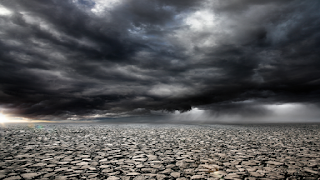Many countries around the world use “cloud seeding” technology to stimulate rainfall, such as the United States, France, and Australia, as well as the UAE, which has witnessed large amounts of rain over the past days.
Some may link the controversial technology to flash floods, but experts say there is actually no relationship between the two events.
But the “cloud seeding” technology, which was developed more than 80 years ago, is not without potential risks, and may lead to “catastrophic effects,” according to experts.
What is “cloud seeding”?
Researchers working at General Electric discovered a strange effect when conducting experiments on how clouds form in the laboratory. They found that when water vapor becomes very cold, between -10°C and -5°C, it will not necessarily form ice crystals.
However, when the researchers added a fine powder of silver iodide (a chemical used in photography), they were amazed that the water froze instantly.
This is because water vapor cannot form crystals on its own; it needs something to form a "core" around which to condense. In natural clouds, these "cloud condensation nuclei" may be provided by bacteria or small dust particles, but researchers have now found a way to create them artificially.
The "cloud seeding" technique works by applying it to natural clouds, where "silver iodide" or table salt is injected into the clouds, causing ice crystals to form quickly, which eventually fall in the form of snow or rain depending on the weather condition.
“Cloud seeding is done either by launching chemicals from the ground, injecting them directly from aircraft, or launching them into the clouds using rockets,” said Johan Jacques, chief meteorologist at KISTERS.
Where is cloud seeding used?
This technology has been used in about 50 different countries, including the UAE, which has been running an advanced cloud seeding program since the 1990s, where about 1,000 hours of “cloud seeding” missions are carried out annually.
The United States has a very long history of “cloud seeding” missions, starting in 1947 with Operation Cirrus, in which the US military dumped about 90 kg of dry ice into a hurricane off the coast of Florida.
Although there is no evidence that the mission had any impact, some threatened to file lawsuits against the state after the hurricane unexpectedly changed its paths.
In 2018, Wyoming, Utah and Colorado entered into a cost-sharing agreement to fund cloud seeding missions.
In Australia, cloud seeding experiments began in 1947 and continue to this day.
China is the most productive supporter of weather modification technology. For many years, the Bureau of Weather Adjustment has used "cloud seeding" technology to end droughts, fight wildfires, and avoid rainfall during military parades.
This technology is not only used to increase rainfall, as it is used in countries such as Spain, France and Germany mainly to prevent hail.
Why is "cloud seeding" controversial?
Many may disagree with the application of cloud seeding, due to concerns about flash floods.
But Dr Frederic Otto, a leading weather expert from Imperial College London, explained: “Cloud seeding cannot produce massive amounts of rain. The technique is modifying an existing cloud, and you cannot turn a small cumulus cloud into a thunderstorm just by During cloud seeding.
The biggest concern, Otto added, is that “cloud seeding” is being used as a substitute for effective action on climate change, which is the real reason behind increased rainfall.
She continued: “Cloud seeding is another obvious strategy to avoid demands to stop burning fossil fuels. If humans continue to burn oil, gas and coal, climate change and heavy rainfall will continue.”
Tags:
catastrophic effects
cloud seeding
fight wildfires
fine powder
flash floods
heavy rainfall
science
silver iodide
stimulate rainfall
topnews
water froze






Good
ReplyDeleteGreat
ReplyDeleteGood
ReplyDeleteWhat is “cloud seeding”?
ReplyDeleteCloud seeding technology is gaining traction for stimulating rainfall in arid regions, but it remains controversial. While it offers potential benefits, such as combating drought, experts caution that it cannot create massive downpours from small clouds. The larger concern is that it may be used as a substitute for real climate action. Addressing climate change remains the fundamental solution to extreme weather patterns.
ReplyDeleteGood
ReplyDeleteGood
ReplyDeleteGood
ReplyDeleteGood
ReplyDeleteGood
ReplyDeleteGood
ReplyDeleteGood
ReplyDeleteGood
ReplyDeleteGood
ReplyDeleteGood
ReplyDeleteInformative
ReplyDelete